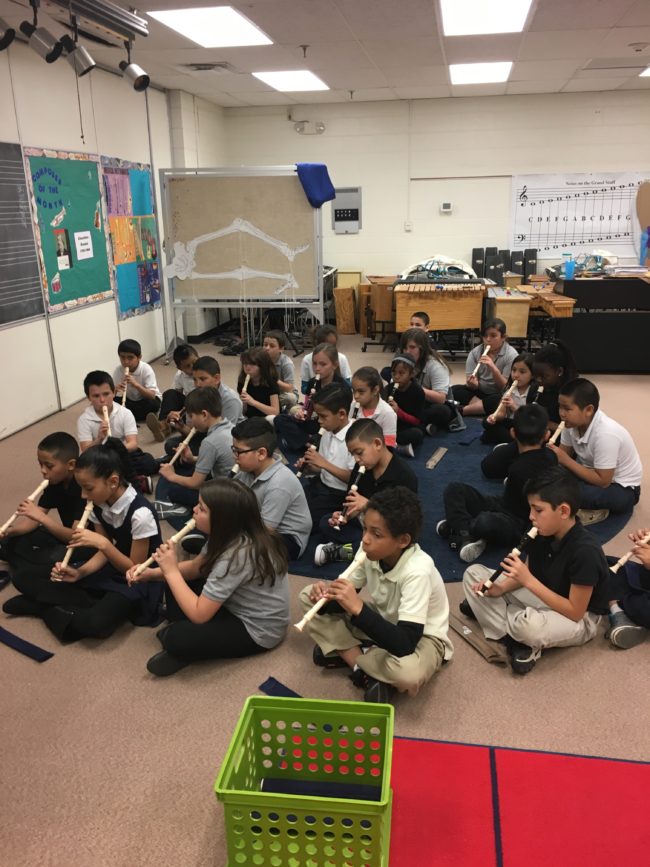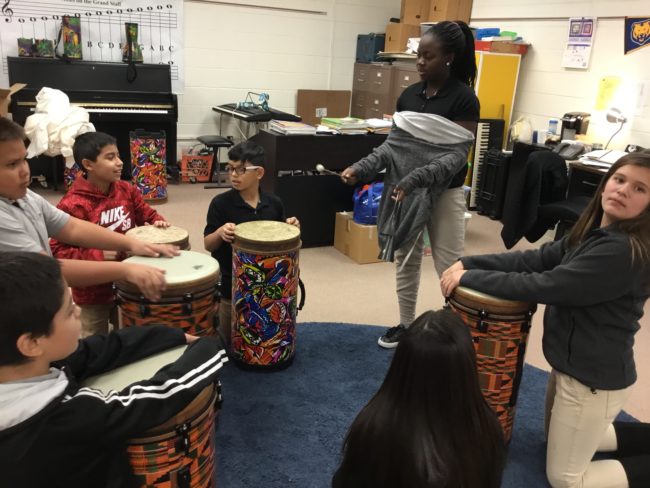06.17.19The TLAC Way in the Music Classroom: A Guest Post by Stephanie Kelln

I had the pleasure of meeting music teacher Stephanie Kelln at one of our recent workshops. She hails from Colorado, teaches at Centennial Elementary in Evans, and approached meat one of the breaks to ask about using TLAC techniques in the Music classroom. My answer wasn’t great honestly, but hers–a blog post about how she used TLAC with her students was. She writes:
Centennial Elementary School, in Evans, Colorado, is a 100% free-and-reduced lunch school with a significant English language learner population. A few years ago, we were on Priority Improvement status with the Colorado Department of Education. Our standardized test scores were below 40% proficient. Behavior was out of control, with over 500 office discipline referrals. Through the use of Teach Like a Champion strategies to create a consistent and rigorous implementation of behavior and academic expectations, we turned our school around. Our test scores increased to over 60% proficient. For the 2018-2019 school year we had a total of 89 office discipline referrals. We did this turnaround with huge changes to the general education classroom, but that was not all it took. Changes to non-classroom environments – recess, lunch, specials – were required as well to make this a whole-school turnaround. I have the pleasure of teaching music and drama to our diverse student body. Here is what turnaround looked like in my music classroom.
The TLAC Way
When first introduced to Teach Like a Champion, I realized that the TLAC way was not about the strategies as much as the philosophy. The philosophy that every kid can succeed, high expectations is the way to success, and that a warm-strict approach was the most effective way to communicate and hold students to high expectations. It was these three pillars – success for all, high expectations, and warm-strict teaching – that sold me to the TLAC way. From there, it was easy to take what I could from the individual techniques into my music classroom to ensure success for students in my content area.
Success for All
A poster on the wall of my room says, “100% Participation.” For a subject dependent upon observation, participation, and performance, 100% is key. Thus, the first TLAC strategy I began implementing in my classroom was the tools for gaining success for all through 100%. Within these tools is what I like to call my favorite strategy: No Opt Out. I had been struggling for a while on how to get my non-participators to join the class while also bringing those partial-participators to a increased amount of effort. No Opt Out was the answer.
I will never forget the first time I used this strategy. A third grader, Ernie*, notorious for opting out of anything he could, gave me his typical shrug in response to a question I asked. Here’s how the exchange went down:
Me: Ernie, what is the name of the note on the third line of the staff?
Ernie: <Shrug>
Me: I’ll come back to you. Samantha, what is the note on the third line of the staff?
Samantha: B
Me: Ernie, what is the note on the third line of the staff?
Ernie: <Shrug> (I repeated this process at least half a dozen times, always coming back to Ernie. It finally worked.)
Me: Ernie, what is the third space of the staff? You can ask a friend, or repeat what Jamie just answered.
Ernie: (In a low voice) C?
Me: Yes! You got it! Let’s move on. Everyone please pick up your recorders.
From that day, until Ernie finished elementary school, he gave me full participation. In fifth grade, he played in our drum ensemble. His positive participation rippled to all the students in his class. After that first No Opt Out, every time I used the strategy required less returns to the non-participatory student. Soon, every student who came into my room knew that 100% means 100%. I could move on to the next strategy in 100%, which was not only participation from 100% of the students, but each student giving 100% effort. This is where my high expectations were challenged.

High Expectations
In a music performance, it is not enough to have 100% of the students merely participating. Singing voices must be strong, rhythms accurate, and harmonies aligned in order to create a quality performance. The TLAC strategy of Do It Again communicates and reinforces high expectations for 100% effort.
I’m in my class in front of fourth graders practicing for our school musical. The accompaniment music starts. I model singer’s posture with my own body. I give the cue, a breath, and they start singing. At that moment, if their sound is not the full-bodied singing I expect, we start over. Accompaniment music. Posture. Breath, and singing that fills the room with sound.
Do It Again encapsulates the philosophy that achievement is not 100% until each student is giving 100% of themselves. This philosophy aligns with my curricular goals of guiding students through the process of making beautiful, quality music together.
Warm-Strict
My effectiveness in the above strategies would have been compromised had it not been for strategy, and the philosophy, of Warm-Strict. To me, this strategy is about the thought process before my actions. How am I interacting with my students both warmly and strictly? Not just in my words and actions, but in my classroom arrangement, my curriculum, my choice of materials and units. Warm-Strict implies a way of approaching students with care but also accountability. That is why, in order to maintain high expectations and ensure success for all, Warm-Strict is indispensable.
Conclusion
As a specialist, it is easy to fall into the trap of assuming general education classroom strategies are not specialist classroom strategies. We can look at the approaches teachers take with academic content and fail to see the connections and adaptations to our own content. When we step back from the details of academic strategies and look at the guiding philosophies of those strategies, we can find infinite ways to implement general education classroom strategies into our own diverse classrooms. That is the Teach Like a Champion way. Not a set of ‘to-do’ items or actions catered to academics, but an approach to education that every student is a scholar.
So happy to see a posting from a TLAC music teacher! I teach middle school general music, band and high school jazz ensemble and use TLAC techniques every day. The book is always a source of insight, reminders, and inspiration.
A few techniques high on my list:
Threshold / Strong Start – we shake hands at the door. Retrieval practice based Do Now is on the SMART board. No questions asked. Straight to work.
For music theory lessons: Cold Call, No Opt Out, Stretch It. Format Matters (sharps and flat signs go on the left side of the note, not the right).
I use timers a lot: “You all have two minutes to work through the notes in this passage. Go!” During those two minutes I Circulate, giving individual corrections. Then back to the podium to conduct the ensemble.